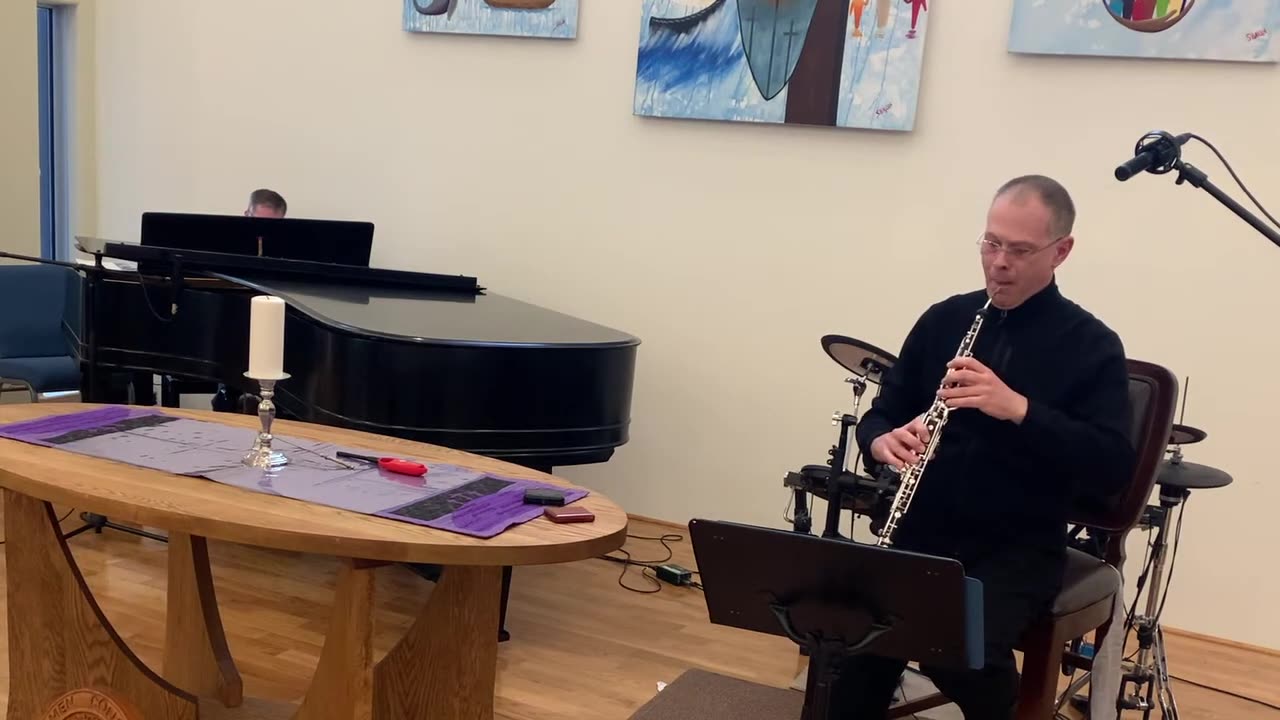Premium Only Content

Gaetano Donizetti_ Andante Sostenuto (Oboe d'Amore)
Oboe: The main instrument of interest.
Instrumental Music: Music composed and performed without vocals or singing.
Woodwind: Oboe belongs to the woodwind family of instruments.
Double Reed: Oboe has a double reed mechanism for producing sound.
Solo: Oboe is often used as a solo instrument in compositions.
Chamber Music: Oboe is frequently featured in chamber music ensembles.
Orchestra: Oboe is an integral part of the orchestra, often found in the woodwind section.
Concerto: A musical composition featuring the oboe as the solo instrument, accompanied by an orchestra.
Etude: A musical piece designed to improve specific technical aspects of oboe playing.
Articulation: The way notes are started, sustained, and ended on the oboe.
Tone Color: Oboe's unique timbre and ability to produce different colors in its sound.
Embouchure: The way a player's mouth and lips interact with the oboe's reed and mouthpiece.
Breathing Technique: Proper breath control is essential for oboists to produce consistent sound.
Vibrato: A technique where the pitch of a note oscillates slightly to add expressiveness.
Trill: Rapid alternation between two adjacent notes.
Orchestration: The arrangement of musical parts for different instruments in an ensemble or orchestra.
Reed-Making: Crafting and adjusting oboe reeds for optimal sound production.
Melody: Oboe often carries the main melody in compositions.
Harmony: Oboe's role in supporting harmonies and chords within a piece.
Expressiveness: Oboe's ability to convey emotions and feelings through its sound.
Phrasing: Shaping musical lines by grouping notes into meaningful phrases.
Dynamics: Variations in loudness and intensity in the oboe's sound.
Concert Pitch: Oboe is a transposing instrument, sounding a different pitch than written.
Crescendo: Gradually increasing the volume of the sound.
Decrescendo: Gradually decreasing the volume of the sound.
Legato: Smooth and connected playing of notes.
Staccato: Short and detached playing of notes.
Soloist: The oboe player performing a solo part in a composition.
Composer Names: Mention of composers known for writing significant oboe pieces, like Mozart, Strauss, and Vaughan Williams.
Repertoire: The collection of music pieces available for oboe performance.
These keywords should provide you with a solid foundation to explore various aspects of oboe instrumental music.
-
 2:48
2:48
Steven Crowder
7 hours agoCROWDER CLASSICS: What’s This? | Nightmare Before Kwanzaa (Nightmare Before Christmas Parody)
151K10 -
 LIVE
LIVE
LFA TV
8 hours agoLFA TV CHRISTMAS EVE REPLAY
762 watching -
![ROSEANNE BARR - Her Journey, TRUMP, and the MAGA GOLDEN AGE! [INTERVIEW]](https://1a-1791.com/video/s8/1/M/m/B/2/MmB2v.0kob.1-small-ROSEANNE-BARR-Her-Journey-T.jpg) 51:35
51:35
Dr Steve Turley
1 day ago $8.34 earnedROSEANNE BARR - Her Journey, TRUMP, and the MAGA GOLDEN AGE! [INTERVIEW]
18.2K26 -
 DVR
DVR
The Tom Renz Show
1 hour agoMerry Christmas - The Tom Renz Show Christmas
2.3K -
 2:59:10
2:59:10
Wendy Bell Radio
12 hours agoThe Bridge Too Far
107K108 -
 1:03:45
1:03:45
Donald Trump Jr.
1 day agoHappy Festivus: Airing Our Grievances and Stopping The Swamp w/Sean Davis | TRIGGERED Ep.201
385K502 -
 1:30:30
1:30:30
Game On!
15 hours ago $6.61 earnedTop 5 things you need to know for Sports Christmas!
44.2K3 -
 1:58:10
1:58:10
Robert Gouveia
1 day agoMatt Gaetz REJECTS Report, Sues Committee; Luigi Fan Club Arrives; Biden Commutes; Festivus Waste
270K206 -
 1:31:40
1:31:40
Adam Does Movies
1 day ago $14.82 earnedThe Best & Worst Christmas Movies! - LIVE!
99.2K8 -
 58:10
58:10
Kimberly Guilfoyle
1 day agoAmerica is Back & The Future is Bright: A Year in Review | Ep. 183
189K70